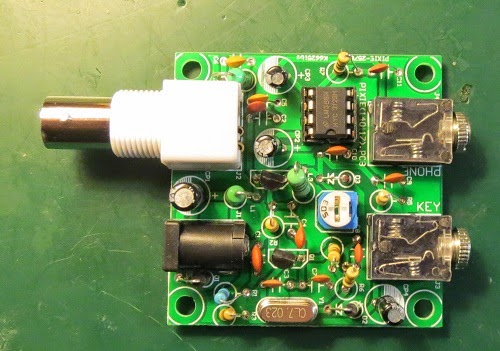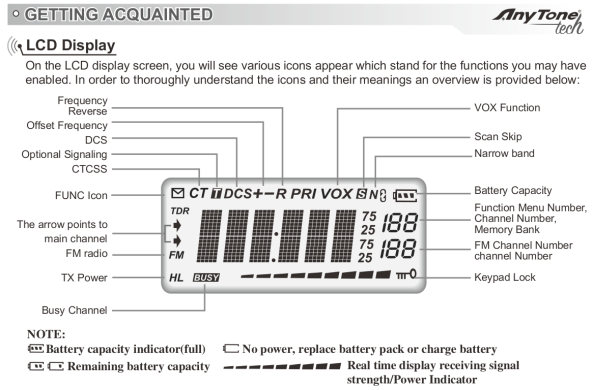 Pixie (40m) build completed this evening
Pixie (40m) build completed this evening
 |
| Completed 40m Pixie assembly |
This evening, I completed the build of the 40m Pixie PCB assembly. It will get checked over for dry joints or shorts in the morning and air-tested shortly.
A very half-hearted attempt at the 6m UKAC this evening was aborted because of my poor voice but I only worked 3 locals in the short time I was on with my V2000 vertical.
I really wanted to crack on with the Pixie build, although I was not expecting to finish the built today. The small PCB based kit does represent very good value.
Roger Lapthorn, G3XBM, is a regular contributor to AmateurRadio.com and writes from Cambridge, England.
 Closing in on Mountain Goat
Closing in on Mountain Goat
Sometimes my busy schedule gives me opportunities to activate summits that I wouldn't otherwise get to activate. A case in point was travelling to the IBC in Memphis. My drive from San Antonio took me through eastern Oklahoma and western Arkansas. Both areas are target rich environments for SOTA activators so I was able to accumulate a lot of points. So many points in fact that, when added to a recent trip to Santa Fe, NM and the Davis Mountains in Texas I am knocking on the door of the SOTA Mountain Goat award which requires 1,000 activator points. I am now at 965 points.
Not just because I am getting close to earning MG status, but I believe this is one of the toughest awards in ham radio if you factor in the physical side of it. Nearly all awards in the amateur radio world require you sit on your derriere for hours or even days at a time. You will never mistake a ham convention for a gathering of tri-athletes. Staying fit enough to do these climbs has me in the best shape I've been in years. That said, you don't have to be in fantastic shape to participate in SOTA. There are mountains or hills that qualify that can be driven up or just a short walk will get you there. But it does require that you get outside, which is a good thing. And I promise, the more you do it, the more you will want to do.
I've learned some much about portable QRP operating while working toward this award. It's been said that when you achieve MG status, you have a Ph.D in portable radio operation. When I think about my first activation versus the way I operate now, it's night and day. I travel so much lighter and my station is much more efficient. I can be operating within 10 minutes of arriving on the summit with a station that will generate a pile-up and make DX contacts on multiple bands.
So I am anxious to get the 1,000th point, which hopefully will be within the next couple of weeks. Below is a video and picture from a couple of summits I activated last weekend in the Davis Mountains of Texas. The Davis Mountains are the home of the McDonald Observatory which, as you will see below, is a dominant feature on the horizon in that area. BTW, Mount Locke, where the observatory sits, is a 10 pointer that you drive up, however you have to get of the house to get there. The picture is from Mt. Arabella, a fairly steep 8 pointer that will take the average person 30 -45 minutes to ascend. The video is from Peak 6411 outside of Ft. Davis. It also is a drive-up. I use the Alex Loop on drive up mountains, but End Fed Half Wave (EFHW) on hikes of any distance.
Since beginning my chase for MG my longest hike was doing Santa Fe Baldy, in Santa Fe, NM. A 15 mile roundtrip up to 12,000+ ft. ASL. The tallest mountain I've done is Mt. Sherman in Colorado at 14,036 ft. ASL.
I 'm sure I will make another posting to the Blog when I get the 1,000th point. I can't wait to become a certified Old Goat!
 |
| McDonald Observatory from Mt. Arabella |
Mike Crownover, AD5A, is a regular contributor to AmateurRadio.com and writes from Texas, USA. Contact him at [email protected].
 Android smartphone with built-in UHF transceiver
Android smartphone with built-in UHF transceiver
- Otium Android smartphone
- Screw-on SMA antenna
Over on Reddit, there’s a discussion going on about an Android smartphone with some sort of built-in UHF radio (FRS/GMRS). It appears to be a Chinese-made Android phone from Otium called the Otium V8. It’s for sale on Amazon for about $300.
Below is a screenshot from someone asking how it works. The frequency is a shared FRS/GMRS channel (in the U.S). I would expect a radio like this to be “channelized” and not show a frequency directly on the screen — which makes me wonder what other frequencies one might be able to enter…?
Are GSM phones with built-in radios common? Has anyone ever used one of these?
From the screenshot of the built-in PTT app, it looks like it has an adjustable power level, does frequency splits, PL/CTCSS, and even has a narrow/wide bandwidth selection.
What chip are they using to do this? Can it be tweaked with software to transmit/receive “out of range” in the 70cm ham band? I’m curious!
Matt Thomas, W1MST, is the managing editor of AmateurRadio.com. Contact him at [email protected].
 Anytone Tech’s new models: User Manuals
Anytone Tech’s new models: User Manuals
As Brick also mentioned in in his last post about Anytone Tech: the reactions on the new models vary wildly. I think Brick said all there is to say, but I’ll add this thought:
– If a radio is cheap but crap, we complain, but buy it anyway.
– If a radio is good but costs more, we complain, but suddenly the price is all that matters.
Let’s see how these radios perform and at what price point before judging them. I know John of Miklor.com gets (or already has) review samples, and I’m on the list too. To give you some more insight in what these radios can and cannot do, here are some preliminary user manuals (PDF).
ANILE-8R User Manual (Preliminary)
NSTIG-8R User Manual (Preliminary)
OBLTR-8R + TERMN-8R User Manual (Preliminary)
Hans, PD0AC, is a regular contributor to AmateurRadio.com and writes from Almere, The Netherlands. Contact him at [email protected].
 Logbook of the World problems
Logbook of the World problems
Now that I switched shack computers out, I loaded the latest version of Trusted QSL to my shack laptop. I requested a new callsign certificate from that laptop and it arrived today. I tried uploading the certificate to the Trusted QSL program and I keep getting this error:
The certificate is there - the League just e-mailed it to me! I even went to the LotW Website and manually downloaded my certificates - still nothing, same message box pops up. I even tried deleting Trusted QSL and re-installed it thinking there might have been some kind of error when it loaded - no dice.
Any LotW gurus out there have any idea as to what might be going on?
72 de Larry W2LJ
QRP - When you care to send the very least!
Larry Makoski, W2LJ, is a regular contributor to AmateurRadio.com and writes from New Jersey, USA. Contact him at [email protected].
 ISS SSTV reception in Thunder Bay, ON EN58hh
ISS SSTV reception in Thunder Bay, ON EN58hh
Been a long while since I played with satellites or even the ISS for that matter. In fact 2 meters has taken a total backseat for me as it no longer thrills me as far as APRS or even repeaters. IRLP nodes as well just don’t do it like they used to, combine that with only one telephone provider (Thunder Bay Telephone) and major dropouts etc on the IRLP it makes it no fun on nodes.
So turned the FT857 on today after reading about the ISS sending SSTV pictures down to earth. Using a dual band vertical at 25′ and using MMSSTV I was able to copy these pictures this afternoon. (Monday afternoon in Ontario)


 So kinda made my day to see the pictures up on the screen when I got back into the shack.
So kinda made my day to see the pictures up on the screen when I got back into the shack.
Cheers
Fred
VE3FAL
Fred Lesnick, VE3FAL, is a regular contributor to AmateurRadio.com and writes from Thunder Bay Ontario, Canada. Contact him at [email protected].
 CLE191 Results
CLE191 Results
 |
| http://helios.gsfc.nasa.gov/chole.html |
With my Perseus SDR taking 2-minute spectrum captures once per hour, from dusk through dawn, the short propagation lifts become quickly evident ... the majority of my loggings were made during these short windows of propagation:
21 04:00 260 ZXS Prince George, BC, CAN
21 02:00 260 YSQ Atlin, BC, CAN
22 07:00 260 AVZ Terrell, TX, USA
21 02:00 260 AP Sedalia, CO, USA
21 13:00 261 D6 Fairmont Hot Springs Apt, BC, CAN
22 09:00 263 ZQT Thunder Bay, ON, CAN
21 09:00 263 YGK Kingston, ON, CAN
21 09:00 263 YBB Kugaaruk, NU, CAN
21 13:00 263 JDN Jordan, MT, USA
21 08:00 263 3Z Russell Apt, MB, CAN
21 08:00 264 ZPB Sachigo Lake, ON, CAN
21 08:00 266 XD Edmonton, AB, CAN
21 02:00 266 VR Vancouver, BC, CAN
21 08:00 266 SL Turner, OR, USA
21 08:00 266 SAA Saratoga, WY, USA
21 08:00 266 ICK Annette Island, ALS
21 08:00 266 BZ Bozeman, MT, USA
21 13:00 268 ZWL Wollaston Lake, SK, CAN
21 08:00 269 ZW Teslin, YT, CAN
21 04:00 269 YK Castlegar, BC, CAN
21 08:00 269 UDE Delta Beach, MB, CAN
22 09:00 269 SWT Seward, NE, USA
22 09:00 269 PK Park Rapids, MN, USA
22 09:00 269 ISB Sibley Municipal Apt, IA, USA
21 08:00 269 CII Choteau Apt, MT, USA
23 08:00 510 OF Madison, NE, USA
21 10:00 512 HMY Lexington, OK, USA
21 10:00 515 SAK Kalispell, MT, USA
23 08:00 515 PN Ponca City, OK, USA
23 08:00 515 OS Columbus, OH, USA
21 10:00 515 CL Cresent Beach, WA, USA
22 09:00 516 YWA Petawawa, ON, CAN
23 08:00 521 TO Topeka, KS, USA
22 08:00 521 ORC Orange City, IA, USA
21 10:00 521 INE Missoula, MT, USA
23 08:00 524 HRD Hawthorne, TX, USA
21 09:00 525 ICW Nenana, ALS
21 09:00 529 SQM Big Level Isl, ALS
21 08:00 1725 WH2XDE/3 MA
21 08:00 472.4 VE7CNF BC
21 06:00 474 VE7BDQ BC
21 08:00 475.5 WG2XSV WA
In just a few years the Sun should be very very quiet for several winters, offering some superb LF listening once again.
Steve McDonald, VE7SL, is a regular contributor to AmateurRadio.com and writes from British Columbia, Canada. Contact him at [email protected].

















